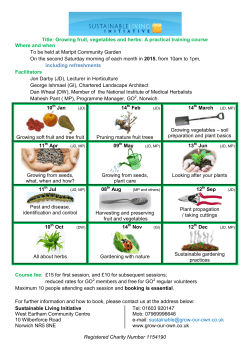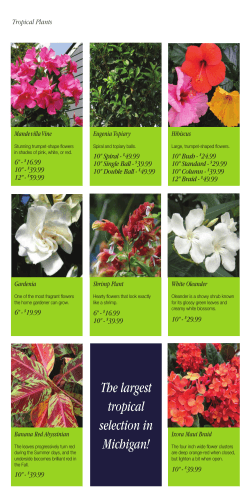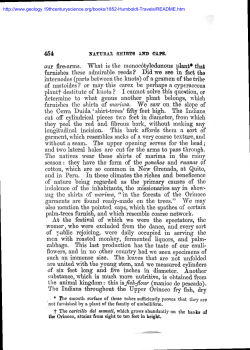
A review on traditional uses and phytochemical properties of
International Journal of Herbal Medicine 2015; 2 (6): 20-23 E- ISSN: 2321-2187 P- ISSN: 2394-0514 IJHM 2015; 2 (6): 20-23 Received: 15-04-2015 Accepted: 26-04-2015 Mariyam Roqaiya Dept. of Ilmul Qabalat wa Amraze Niswan National Institute of Unani Medicine, Bangalore, Karnataka (India) Wajeeha Begum Dept. of Ilmul Qabalat wa Amraze Niswan National Institute of Unani Medicine, Bangalore, Karnataka (India) Sana Fatima Majeedi Dept. of Ilmul Qabalat wa Amraze Niswan National Institute of Unani Medicine, Bangalore, Karnataka (India) Amrin Saiyed Dept. of Ilmul Advia, National Institute of Unani Medicine, Bangalore, Karnataka (India) Correspondence: Mariyam Roqaiya Dept. of Ilmul Qabalat wa Amraze Niswan National Institute of Unani Medicine, Bangalore, Karnataka (India) A review on traditional uses and phytochemical properties of Mimusops elengi Linn. Mariyam Roqaiya, Wajeeha Begum, Sana Fatima Majeedi, Amrin Saiyed. Abstract Herbal medicine is getting popularized in developing and developed countries owing to its natural origin and lesser side effects. Medicinal plants are the valuable and cheap source of unique phytochemicals which are frequently used in the development of drugs against various diseases. Mimusops elengi Linn. is considered as one of the best medicinal plant due to its several therapeutic uses mentioned in Unani as well as ethnomedicine. The various extracts of the plant (bark, fruit, leaves, seed, and flowers) have been reported to be cardiotonic, alexipharmic and stomachic, hypotensive, antibacterial, anthelmintic, antigastric ulcers, teeth cleaner and renewable sources of energy. This review is an attempt to compile and document information on traditional uses and phytochemical properties of Mimusops elengi Linn. Keywords: Mimusops elengi, Therapeutic, Unani, phytochemical 1. Introduction The practices of traditional medicine are based on hundreds of years of belief and observations and analysis, which help in the development of modern medicine. Today, there is widespread interest in herbal drugs. This interest is primarily based upon the belief that herbal medicines are safe, inexpensive and have less adverse effects. The world health organization (WHO) estimates that two third of the world population still depends upon traditional medicines for the treatment of various types of diseases. One such important traditional medicinal plant is Mimusops elengi Linn. Commonly known as “Indian Medlar Tree” or “Bakul tree” [1]. It has important place in Hindus as its fragrant flowers are celebrated in the Puranas and even placed amongst the flowers of the Hindu paradise. Krishna is said to have fascinated the milkmaids of Brindaban on the banks of Yamuna by playing on his flute beneath the Mimusops elengi tree. Kalidasa has also included in his classical Sanskrit literature Mimusops elengi flowers as symbol of love and beauty [2]. This tree served as a staple diet for sages, hermits and people in ancient Indian civilization [3]. In Unani medicine it is known as “Mulsari” and most of the parts of this plant is used in various ways to cure a variety of human diseases like toothache, leucorrhoea, premature ejaculation, syphilis, burning micturition, ulcers of urethra, fever, headache, bodyache, palpitation, loosening of teeth, constipation, weak and spongy gums, pyrorrhea, stomatitis, ulcerated throat [4]. The stembark, leaf and seeds of this plant has folk medicinal uses in toothache, scorpion bite, constipation, dental care and diarrhea [5]. The plant is considered useful by tribals in ulcerated tongue, sores, dropsy and anasarca, smallpox, syphilis, sores and carbuncles, consumption, cough, bronchitis and menorrhagia [6]. The bark of Mimusops elengi contains small amount of brownish-red coloring matter and is used in certain districts of Bengal for dying shades of brown [7]. Wood used for building purpose, piles, bridges, boats, masts, spars, carts, agricultural implements, rice pounders, crushers and oil mills; also used for furniture, cabiniet-work, panels, marline spikes, belaying pins, tools, picture frames, musical instruments and walking sticks. Fruit are edible, also used for preserves and pickles. Kernels yield fatty oil used for edible and lightening purposes. Flowers used for the preparation of an otto used in perfumes [8]. 2. Botanical Description 2.1 Taxonomical Classification Kingdom: Plantae, (Unranked): Angiosperms (Unranked): Eudicots (Unranked): Asterids ~ 20 ~ International Journal of Herbal Medicine Order: Ericales, Family: Sapotaceae, Genus: Mimusops, Species: elengi Linn. 2.2 Botanical name: Mimusops elengi Linn. [9] 2.3 Vernacular Name Unani: Mulsari Sanskrit: Anangaka, Bakula, Chirapushpa, Dhanvi, Gudhpushpa, Kantha, Karuka, Kesha, Mukula, Padyamoda, Sharadika, Sindhugandha, Simhakeshaa, Sthirmukhgandha, Surabhi Tailanga, Varalahdha, Visharada Gujarati: Babhuli, Bolsari, Varsoli, Vovoli Hindi: Bakul, Bolsari, Maulsarau, Maulser, Maulsari Marathi: Bakhor, Bakula, Barsoli, Ovalli, Owli, Vavoli, Wovali, Wowli Malayalam: Elengi, Ilanni, Iranni, Makuram, Bakulam [7,10], Makura, Mukura [6] Tamil: Alagu, Ilangi, Kesaram, Kosaram, Magil, Magilam, Vagulam [7,10] Telgu: Pogada [6,7,10], Vakulamu [6] Punjabi: Maulsari, Maulsiri Bengali: Bakal, Bakul, Bohl, Bukal [7,10] Uriya: Baulo [8,11], Bokulo Assam: Gokul [8] English: Bullet wood, Indian Medlar Nepalese: Bakulapuspa Sinhalese: Munemal German: Affengesict French: karanicum Burmese: Kaya Malaysian: Enengi [7,10] Thai: Pikul [12,13] Trade: Bulletwood [8]. 2.4 Morphological Description A large evergreen tree with dark grey fissured bark [14]. The bark is covered externally by a very thick grey suber on the older branches, which separates in irregular scales, leaving isolated attached portions which consist of five or more distinct suberous layers [15]. The leaves are opposite, elliptic, lanceolate, alternate and glabrous with rounded base, acute apex and wavy margins. They possess a characteristic odour, brittle when dry, astringent in taste and dark green in colour when old [6]. The new leaves mostly appear in February [2]. The flowers are white and fragrant; leaflets lanceolate, the four exterior ones leathery, larger and permanent; corolla onepetalled, tube very short, fleshy, border composed of a double series of segments; the exterior one consists of sixteen, spreading; the interior one of eight, generally contorted and converging, all are lanceolate [15]. Fruition occurs in rainy season [2]. The berry is oval, smooth, yellow when ripe and eadible, one or more celled, according to the number of seeds that ripen; seed solitary, oblong, compressed, attached to the bottom of the cell, covered with a smooth, hard, thick integument, lined with a veined membrane [15]. 2.5 Propagation: by seeds and vegetative method [14]. 2.6 Habitat: It is native to Peninsular India [1, 15, 16], found wild throughout south India, Burma, and Andman Islands in evergreen forests [6, 11, 14, 17]. This large ornamental tree is also cultivated in gardens for its fragrant flowers [6, 11, 17]. 2.7 Phytochemical properties Bark: The important constituent of bark are alkaloids, starch, tannin, saponins contains some caoutchouc, wax, coloring matter, starch and ash forming inorganic salts [7,10,11]. Saponin was isolated from the ethanolic extract of the bark, which on hydrolysis yielded β-amyrin and bassic acid [6, 7, 18]. Hexane soluble fraction of the alcoholic extract yielded taraxerone, taraxerol, α-spinasterol, sodium ursolate and betulinic acid, whereas hexane insoluble fraction yielded β-D-glucoside of βsitosterol and the aqueous extract, gave quercitol. Other pentacyclic triterpenoids betulic acid (2 -167), lupeol (4-167), taraxerol (3-167) and ursolic acid (3-167). Fatty acid ester of α-spinasterol (3-167) was also isolate from bark. The petroleum ether extracts of stem bark yielded α-spinasterol and taraxerol [6, 7]. Steam distillation of bark sample yielded 0.18% of volatile organic matter. The volatile oil constituents of the bark are Linalol, Copaene, Isosafrol, β-caryophyllin, Safrol, δcadinene, Phenol, 2, 5-bis (1-methylethyl)-(Thymol), γcadinene [2]. The bark contains the amino acids such as Tryptophan, Lysine, Methionine, Proline, Glysine and Alanine. The lipid concentration of the bark was ranging from 13.5 to 16.8 mg/gm [10]. Seeds: The seeds contain pentacyclic triterpene acids, mimusopic acid and mimusopsic acid [19]. The ethanolic extract of M. elengi seeds yielded querciyol, dihydroquercetin, quercetin, β-D-glucoside of β-sitosterol and α-spinasterol. The fatty oil from seeds comprised capric, lauric, myristic, palmitic, stearic, arachidic, oleic and linoleic acids; the unsaponifiable matter from the seed fat consisted of β- and γsitosterol [6]. Root: The root contain steroidal saponin, 5α-stigmast-9(11) en-3-O-β-D-glucopyranosyl (→5)-O-β-D-xy-lofuranoside [19]. The roots on extraction with ethanol gave lupeol acetate, taraxerol, α-spinasterol and β-D-glucoside of β-sitosterol. Flower: Fresh flowers of M. elengi on extraction with acetone yielded D-mannitol, whereas on extraction with ethanol it gave β-sitosterol-β-D-glucoside. The ethanolic extract of the flowers yielded quercitol, ursolic acid and a triterpene alcohol which was later identified as lupeol [6]. Leaves: The leaves contain sterols, reducing sugars and tannins [19]. The ethanol extract of M. elengi leaves yielded quercitol, hentriacontane, β-carotene and glucose [6]. Fruit: Pulp of the fruit contains a large proportion of sugar and saponin [11]. 3. Mahiyat (Description in Unani Literature) The tree is 40-50 feet or more in height. Stem is small with several branches. Leaves are slender and smooth [4]. It gives many small flowers in summer season. Colour of flower is sandal [4, 20] and gives peculiar sweet smell like mahua fruit. Dried flowers give more smell. It gives 1 inch long fruit. The colour of unripe fruit is green while of ripe fruit is yellow. The shape of fruit is conical. The pulp of fruit is sweet and astringent in taste [4]. The pulp contain a large seed which contain bitter and foul smelling pulp [4, 20]. This plant has two varieties male and female. Male variety does not produce fruit while female variety produces fruit [4]. 3.1 Actions Mentioned in Unani Medicine Flower: Mufarrah (exhilarant) wa Muqawwi-e qalb wa dimagh (cardiac and brain tonic)[4, 20, 21] Bark: Musakkin-e alam (analgesic) [4, 21, 22], Habis-ud Dam (antihaemorrhagic/styptic) [4, 22], Dafa-e Taffun (antiseptic/antiputrefactive) [4, 21, 22], Dafa-e Safra (cures biliousness) [4, 22], Mumsik-e mani (semen retentive), Dafa-e Humma (antipyretic) [4] Dafa-e jaryan wa sailan [20, 21, 23], Habis-e ishal (antidiarrhoeal) [21], Qabiz (astringent) [23] Ripe fruit: Muqawwi-e meda (stomachic) [4] Unripe fruit: Qabiz (astringent) [4, 21, 23], Mumsik-e mani (semen retentive) [4], Habis-ud Dam (anti-haemorrhagic/styptic), Habis-e ishal ~ 21 ~ International Journal of Herbal Medicine [21] (antidiarrhoeal) Leaf: Habis-ud Dam (antihaemorrhagic/styptic), Dafa-e sailan, Dafa-e Safra [4] Root: Dafa-e sailan [4, 20], Mumsik-e mani (semen retentive) Seeds: Mughalliz-e mani (Inspissant to semen), Mumsik-e mani (semen retentive) [4]. 3.2 Therapeutic Uses Mentioned in Unani Medicine Bark: Powder of bark is used to treat leucorrhoea. Gargling with decoction of bark is used to treat stomatitis, toothache and helps in strengthening the teeth [4, 20, 21]. Its khesanda is used in gonorrhea, burning micturition and urethral ulcers [4, 20, 21, 23]. Powdered bark along with jiggery is used to treat leucorrhoea. Its decoction is also helpful in removing bodyache and fever. Its bark can also be used to treat infertility in women. Wood: Small branches can be used as tooth stick which strengthens the root of teeth and gums Leaf: It is used to treat haemorrhage, leucorrhoea and excessive sweating. Flower: Drinking of juice of flowers [4] and inhalation of powdered dry flower act as a brain and cardiac tonic, used in palpitation [4, 20, 23], stops running nose and headache and also helpful in brain diseases because it contains volatile oil. It reduces excessive sweating because of its anti-perspiratory action. Grinding of flowers along with suhaga and rose can be used in ringworm infection [4]. To stop running nose, its dried flower can also be used in hukka in place of tobacco. Powdered dry flower is used for cleansing the teeth which also strengthens the gums and teeth. Its Arq (distilled) is used as exhilarant [4, 23]. Its flower and fruit along with other astringent medicines can be used for washing wound [4]. Along with sandal its flower is used in making perfume [20]. Fruit: Fruit is used in diarrhoea and chronic dysentery because of its astringent property [4, 20]. Eating ripe fruit acts as cardiac tonic and also helpful in toxaemia due to its anti-putrefactive action. Local application of fruit as liniment removes headache. Murabba (a medicinal preparation in which boiled fruits are preserved in sugar base) can also be made from its fruit. Seed: The suppositories made from seeds used for constipation in children. Keeping seed in mouth strengthens the teeth. Oil obtain from seeds is used for cooking purposes. Root: Gargling with decoction of root reduces stomatitis, strengthens the teeth and gums and also helpful in burning micturition, urethral ulcers. Its decoction is also helpful in bodyache [4]. Bark of root is useful in backache, leucorrhoea, premature ejaculation, and also makes the semen viscid [4, 20]. Mizaj (temperament) Bark: Hot and dry [22], Cold and dry dry [20] Fruit: Cold and dry [21, 23] [20, 21] Flower: Hot and Muzir (adverse effect): Nafakh and qabiz [20, 21, 23] Musleh (correctives): Honey, Roghan [20, 23], Hot and wet food [23] , Maviz munaqqa [21] Badal (substitute): Bark of babool Qabizat [23], Halela siyah [21] [20, 23] , Fruit of babool, Murakkab (formulation): Safoofe sailan [22] 4. Description in ethnomedicine 4.1 Actions mentioned in ethnomedicine Bark: astringent, tonic [1, 14, 24], cooling, anthelminthic [14, 24, 25], antipyretic [6], cardiotonic, alexipharmic, cures biliousness, stomachic [25] Fruit: tonic, astringent [1] Flower: cooling [25, 26], astringent [11, 25, 26], flatulent [25], stimulant(water distilled) [11] Leaves: antioxidant, cytotoxic, analgesic, wound healing, antipyretic Root: aphrodisiac, diuretic, cardiotonic, stomachic, astringent [25] Seed: purgative [11] 4.2 Therapeutic uses mentioned in ethnomadicine Bark: The bark is used as a gargle for odontopathy, ulitis and ulemorrhagia. Tender stems are used as toothbrushes [14, 24]. Rinsing mouth with bark decoction is believed to strengthen the gums, reduce inflammation, and prevent bleeding of gums and stop bad breath caused by pyorrhea and dental caries [26, 27] . It is useful in urethrorrhoea, cystorrhoea [14, 24], diarrhoea and dysentery [1, 8, 14, 24, 28]. It is useful in discharges from the mucous membrane of the bladder and urethra. The bark is said to be much sought after in the Panjaut as a medicine for increasing fertility in women. It is useful in fever as a general tonic [17]. Decoction of bark is used to wash the wounds.9 Flowers: Flowers are used for preparing a lotion for wounds and ulcers [14, 29]. Powder of dried flowers is a brain tonic and is useful as a snuff to treat cephalalgia [14, 24, 26]. Flowers are used as stimulant [8]. The flowers are also used as an expectorant, cures biliousness, liver complaints, diseases of the nose, headache. The smoke of the flower is used for treatment of asthma [25]. Extracts of flowers are used against heart diseases, leucorrhoea and menorrhagia and act as antidiuretic in polyuria and antitoxin. The snuff made from the dried flowers is used in a disease called ahwa in which strong fever, headache, neck pain, shoulder pain and pain in the other parts of the body occurs [9]. The water distilled from the flowers is used as a stimulant medicine, calm anxiety, panic attacks and brain tonic. Fruit: Unripe fruit is used as a masticatory. It is therefore recommended to be chewed for fixing loose teeth [14, 17, 24]. The pulp of the ripe fruit is edible and contains a large amount of sugar and is applied to relieve headache [17]. Ripened fruits facilitate a cure for burning urination. The ripe fruit pounded and mixed with water is given to promote delivery in childbirth [9]. Seeds: From the seeds a fixed oil is obtained by expression, which is used for culinary purpose, for burning [17]. The seeds bruised into a paste and mixed with oil or ghee are made to form suppositories in cases of obstinate constipation especially in children [1, 14, 17, 24]. Seeds are used to fix loose teeth, as an errhine cures nasal congestion and headache [25]. It is also used for curing piles. The seed oil is used in cooking and as a luminant [30]. Leaves: The leaves are used in the treatment of fever, postural eruptions of skin, ulcer, headache, dental diseases, bacterial diseases [25, 31]. Leaves are used as an antidote for snakebite [32]. Leaf is one of Sushruta’s snake remedies. Half teaspoonful of expressed juice of fresh leaves is poured in nostrils in stupor and coma [33]. Boiled leaves are applied to the head as a cold compress for headache and juice of the leaves squeezed into ~ 22 ~ International Journal of Herbal Medicine the eye for sore eyes [34]. Root: Decoction of a root bark along with the milk taken in the morning for three days could strengthens the teeth of even an old person [7]. 5. Conclusion In the present comprehensive review, we referred primary and secondary data to compile the information based on taxonomy, origin, distribution, description, phytoconstituents and traditional claims on Mimusops elengi. There is a grim need to isolate and identify new compounds from different parts of the tree and also more studies are needed before the pharmacological properties of Mimusops elengi can be utilized in therapy. 6. References 1. Bhattacharjee SK. Handbook of Medicinal Plants. Edn 4, Pointer publishers, Jaipur, 2004, 224-225. 2. Kadam PV, Yadav KN, Deoda RS, Shivatare RS, Patil MJ. Mimusops elengi: A Review on Ethnobotany, Phytochemical and Pharmacological profile. Journal of Pharmacognosy and Phytochemistry 2012; 1(3):64-74. 3. Kiyasudeen K, Ismail SA. Pest repellent potential of Mimusops elengi against some common pests in Jasminum sambac. International Journal of Life Science Research 2013; 1(1):5-10. 4. Ghani N, Khazainul Advia, Idarae Kitabul Shifa. New Delhi, YNM, 482-485, 1273, 1274. 5. Anonymous. Medicinal Plants in Folklores of Bihar Orissa. CCRUM, New Delhi, 2001, 345. 6. Anonymus. Medicinal plants of India Indian Council of Medical Research, New Delhi, 1987, II:257-259. 7. Gami B, Pathak S, Parabia M. Ethnobotanical, phytochemical and pharmacological review of Mimusops elengi Linn. Asian Pac J Biomed 2012; 2(9):743-748. 8. Kashyapa K, Chand R. The Useful Plants of India. National Institute of Science Communication and Information Resources, New Delhi, 2006, 375. 9. Mimusops elengi. Last modified on 12 February, 2015 [cited 2015, 12 April]. Available from: http://en.wikipedia.org/wiki/Mimusops_elengi 10. Padhi M, Mahapatra S, Panda J, Sahoo BM. Phytochemical and pharmacological review of Mimusops elengi Linn. American Journal of Pharm Tech Research 2012; 2(6):213-230. 11. Nadkarni KM, Nadkarni AK. Indian Materia Medica. 3rd revised and enlarged edition. Vol I. Popular Prakashan Private Limited, Mumbai, 2009, 800-801. 12. Bhore SJ, Preveena J. Micropropagation of Mimusops elengi Linn. Identification of Suitable Explant and Comparative Analysis of Immature Zygotic Embryos Response on Three Basal Media. American-Eurasian J Agric & Environ Sci 2011; 10(2):216-222. 13. Boonyuen C, Wangkarn S, Suntornwat O, Chaisuksant R. Antioxidant Capacity and Phenolic Content of Mimusops elengi Fruit Extract. Kasetsart J (Nat. Sci.) 2009; 43:2127. 14. Prajapati ND, Purohit SS, Sharma AK, Kumar T. A Handbook of Medicinal Plants. Agrobios, Joudhpur, 2009, 345. 15. Dymock W, Warden CJH, Hooper D. Pharmacographia Indica- A History of the principal drugs Srishti Book Distributors, New Delhi, 2005, II:362-363. 16. Chopra RN, Nayar SL, Chopra IC. Glossary of Indian Medicinal Plants. Edn 1, CSIR, New Delhi, 2009, 167. 17. Nadkarni KM. Indian Plants and Drugs with their Medical properties and Uses. New Srishti Book Distributors, Delhi, 2005, 234. 18. Gupta PC. Mimusops elengi Linn. (Bakul)-A Potential Medicinal Plant: A Review. Int J Pharm Phyto Pharmacol Res 2013; 2(5):332-339. 19. Anonymous. The Wealth of India, Raw materials. J-Q. NISCIR, New Delhi, 2003, IV:134-135. 20. Kabeeruddin M. Makhzanul Mufradat. Ejaz Publication House, New Delhi, 2007, 141, 142, 556, 557. 21. Mohd. R. Kanzul Advia Mufredah. University Publication Unit, Aligarh, 1985, 453-455, 650- 651. 22. Anonymous. Standardisation of Single Drugs of Unani Medicine Edn 1, Part 4. CCRUM Department of AYUSH, New Delhi, 2006, 182-184. 23. Hakeem MAH. Bustan ul Mufradat. Idarae Kitabul Shifa, New Delhi, 2002, 176, 177, 563. 24. Prajapati ND, Kumar U. Agro’s Dictionary of Medicinal Plants. Agrobios (India), Jodhpur, 2003, 214. 25. Padhi M, Mahapatra S. Evaluation of Antibacterial Potential of Leaf extracts of Mimusops elengi. Int Res J Biological Sci 2013; 2(7):46-49. 26. Pimpare SS, Chaudhari CA, Sali LP, Jain NP, Gadgoli CH. Volatile oil of Mimusops elengi Linn (Sapotaceae) as a source of Thymol. Int J Pharm Tech Res 2012; 4(1):250257. 27. Ganesh G, Abhishek T, Saurabh M, Sarada NC. Cytotoxic and apoptosis induction potential of Mimusops elengi L. in human cervical cancer (SiHa) cell line. Journal of King Saud University-Science 2014; 26:333-337. 28. Ali MA, Mozid MA, Yeasmin S, Khan AM, Sayeed MA. An Evaluation of Antimicrobial Activities of Mimusops elengi Linn. Research Journal of Agriculture and Biological Sciences 2008; 4(6):871-874. 29. Narayanaswamy N, Rohini S, Duraisamy A, Balakrishnan KP. Antityrosinase and antioxidant activities of various parts of Mimusops elengi: a comparative study. International Journal of Research in Cosmetic Science 2011; 1(1):17-22. 30. Gopalkrishnan B, Shimpi SN. Seeds of Mimusops elengi Linn. Pharmacognosy and phytochemical studies. IJPPR 2011; 3(1):13-17. 31. Karmakar UK, Sultana R, Biswas NN. Antioxidant, analgesic and cytotoxic activities of Mimusops elengi Linn. Leaves. IJPSR 2011; 2(11):2791-2797. 32. Ali MA, Mozid MA, Yeasmin S, Khan AM, Sayeed MA. An Evaluation of Antimicrobial Activities of Mimusops elengi Linn. Research Journal of Agriculture and Biological Sciences 2008; 4(6):871-874. 33. Sehgal S, Gupta V, Gupta R, Saraf SA. Analgesic and Antipyretic activity of Mimusops elengi L. (Bakul) leaves. Pharmacologyonline 2011; 3:1-6. 34. Kar B, Kumar RBS, Karmakar I, Dolai N, Bala A, Mazumder UK et al. Antioxidant and in vitro antiinflammatory activities of Mimusops elengi leaves. Asian Pacific Journal of Tropical Biomedicine 2012; 976-980. ~ 23 ~
© Copyright 2025










